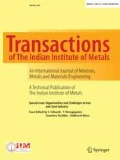Abstract
In this paper, a model of heat transfer of melt flow on a vibration wall has been established. Calculation results show that the temperature boundary layer thickness decreases with the increase of vibration frequency and amplitude. As the vibration frequency and amplitude increase, the heat transfer coefficient between alloy melt and slope and between cooling water and slope increase. Cooling rate of melt can reach 400-600 K/s which belong to the sub-rapid solidification regime. The heat transfer mode doesn’t change during the flow process, so vibration not only strengthens the cooling rate of melt, but also stabilizes heat transfer between melt and slope. The grain size of solidification microstructure decreases with increasing vibration intensity, which indicates that vibration increases cooling rate and accelerates nucleation rate. So, the established model agrees with verification experiment, and can relatively well explain the heat transfer and cooling rate of melt flow on vibration plate.







References
Fan Z, Wang Y, Xia M, and Arumuganathar S, Acta Mater 57 (2009) 4891.
Wannasin J, Canyook R, Burapa R, Sikong L, and Flemings M C, Scripta Mater 59 (2008) 1901.
Eskin G I, Ultrasonic Treatment of Light Alloy Melts. Amsterdam, Gordon & Breach 4-5 (1998) 55.
Zocchi M L, Clin Plast Surg 23 (1996) 575.
Omura N, and Murakami Y, Mater Trans 59 (2009) 2604.
Fujii N, Okada S, Morimoto S, and M. Fujii, J Jpn Inst Light Met 33 (1983) 392.
Zhang H, Tao H B, Li F, Wang M, Huang W D, and Zhao P, Iron & Steel 43 (2008) 20.
Guan R G, Zhao Z Y, Zhang H, Lian C, Lee C S, and Liu C M, J Mater Process Tech 212 (2012) 1430.
Kund N K, Trans Nonferr Metal Soc 24 (2014) 3465.
[10] Khosravi H, Eslami Farsani R, and Askari P M, T Nonferr Metal Soc 24 (2014) 961.
Guan R G, Zhao Z Y, Chao R Z, Feng Z X, and Liu C M, Trans Nonferr Metal Soc 22 (2012) 2871.
Shen Y S, Li B W, and Lin W M, Basic Principles of Metallurgical Transmission. Metallurgical Industry Press, Beijing (2000).
Yu J C, and Xin L Z, J Eng Thermophys 26 (2005) 131.
Guan R G, Zhao Z Y, Huang H Q, Lian C, Chao R Z, and Liu C M, Acta Phys Sin 61 (2012) 1.
Wang X, Chao R Z, Guan R G, Li Y D, and Liu C M, Acta Phys Sin 64 (2015) 1.
Acknowledgements
Thank for the supports of National Natural Science Foundation of China under Grant Nos. 51474063 and 51674077, and Fundamental Research Funds for the Central Universities under Grant N150204016.
Author information
Authors and Affiliations
Corresponding author
Rights and permissions
About this article
Cite this article
Wang, X., Guan, RG. Heat Transfer and Cooling Rate Model of Flow Melt on Vibration Wall. Trans Indian Inst Met 71, 1635–1641 (2018). https://doi.org/10.1007/s12666-018-1299-7
Received:
Accepted:
Published:
Issue Date:
DOI: https://doi.org/10.1007/s12666-018-1299-7

